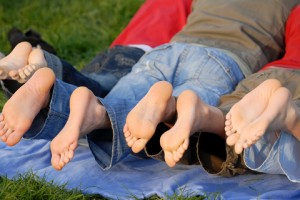Change Is Good – Until It Gives You a Blister
I belong to a gym that offers several different types of group exercise classes. While many of these classes are of interest to me, the schedule never seems to work in my favor so I haven’t had a chance to give any a try. But due to a one-time hiccup in my usual schedule, I was able to attend a turbo kick boxing class this week. I was very excited to try something different from my usual gym workout.
While the class was more of a hyper-speed aerobic workout (with a few punches thrown in for good measure) than a traditional kick boxing workout – it was an effective cardio workout nonetheless. Just when I started getting the hang of when to cross and when to jab, I realized the ball of my right foot was starting to get sore. A few minutes later, I knew I was starting to form a blister. Apparently, all of the bouncing and pivoting on the balls of my feet, which I am not used to, combined with my thicker workout socks, was my body’s way of saying thank you for changing up my workout routine.
While the blister isn’t too bad, nothing like the cringe-inducing, fluid-filled behemoth in the film Run, Fat Boy Run (excellent movie, by the way), it still needs to be dealt with so I did some research on blister prevention and treatment. The Mayo Clinic suggests the following treatment:
Don’t puncture a blister unless it’s painful or prevents you from walking or using one of your hands. If you have diabetes or poor circulation, call your doctor before considering the self-care measures below.
To relieve blister-related pain, drain the fluid while leaving the overlying skin intact. Here’s how:
- Wash your hands and the blister with soap and warm water.
- Swab the blister with iodine or rubbing alcohol.
- Sterilize a clean, sharp needle by wiping it with rubbing alcohol.
- Use the needle to puncture the blister. Aim for several spots near the blister’s edge. Let the fluid drain, but leave the overlying skin in place.
- Apply an antibiotic ointment to the blister and cover with a bandage or gauze pad.
- Cut away all the dead skin after several days, using tweezers and scissors sterilized with rubbing alcohol. Apply more ointment and a bandage.
Call your doctor if you see signs of infection around a blister — pus, redness, increasing pain or warm skin.
Active.com suggests the following preventative measures:
-
Spread petroleum jelly or talcum powder over areas which develop blisters frequently. This will cut the friction.
-
Change socks, shoes or road surfaces that cause the problem.
-
Pad areas of your foot which protrude with foam padding, moleskin, or other products made for this purpose.
-
For chronic problems, you can relieve pressure points with shoe modifications or orthotics.
The gift of hind sight is 20/20. The next time, if there is a next time, I will try a little petroleum jelly and wear my running socks which are thinner and form fitting . I’m off to sterilize my needle now. Wish me luck!

Recent Comments